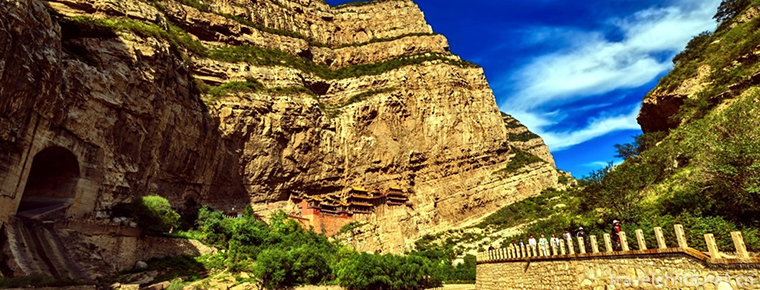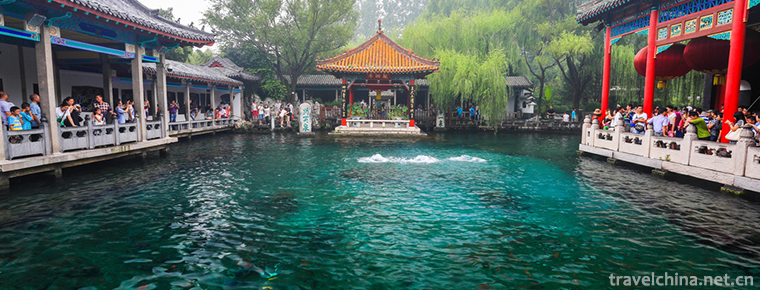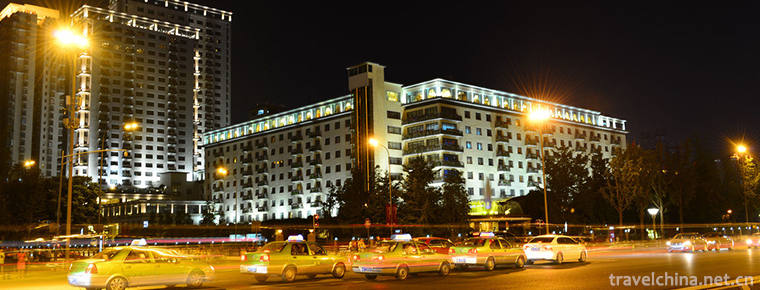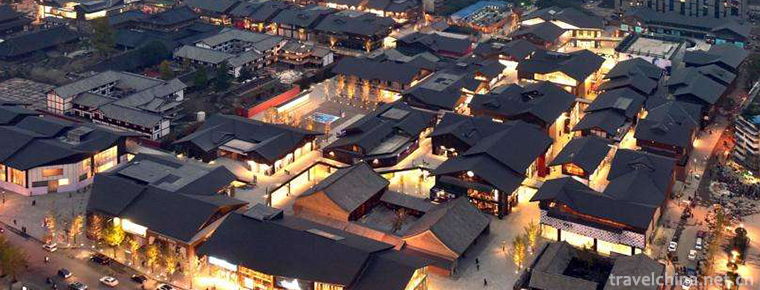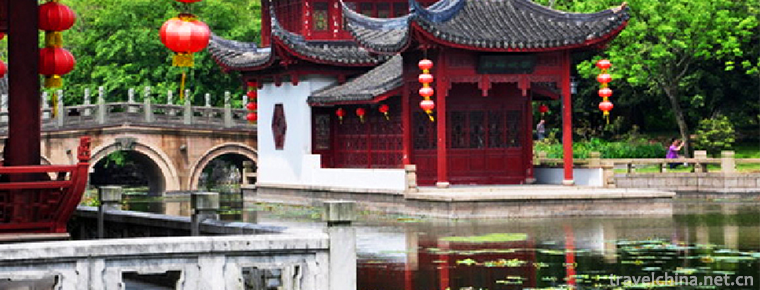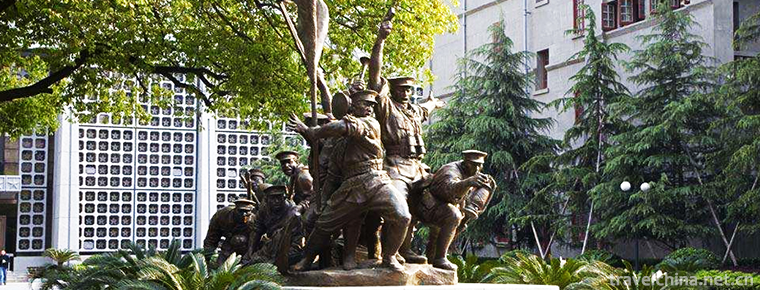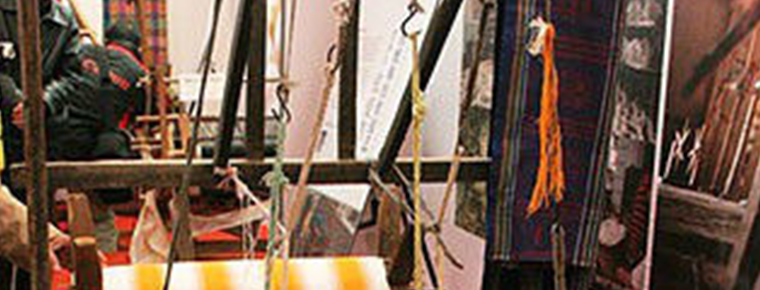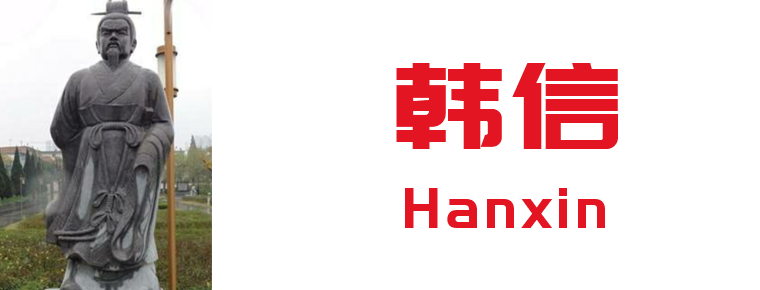BaoGuGu National Forest Park
Baoqianggu National Forest Park, Shandong Province, is located in the southeast of Shanting District, Zaozhuang City, Shandong Province. Its geographical coordinates are 34 degrees north latitude 59'4.22 and 117 degrees east longitude 42'36.98 with a total area of 666.67 hectares.
Baoqiaogu National Forest Park in Shandong Province belongs to the Yimeng Mountains and is a gorgeous group in the southern part of the Taiyi Mountains. It is mainly composed of the Lower and Middle Cambrian strata of Lower Paleozoic, which are mainly composed of carbonate rocks and rock associations of sandy shale and sandstone. The park is dominated by Xiong'er Mountain, with Shuanglong Rift Valley, Karst Cave Group, Longzhaya Cliff and Landslide Geological Disaster Relics. The area is mountainous, ravines vertical and horizontal, there are more than 40 large and small hilltops, elevation between 211-584 meters.
In September 1992, Baoqiao National Forest Park in Shandong Province was approved as a national forest park by the State Forestry Administration.
Location context
Baoqianggu National Forest Park, Shandong Province, is located in the southeast of Shanting District, Zaozhuang City, Shandong Province. Its geographical coordinates are 34 degrees north latitude 59'4.22 and 117 degrees east longitude 42'36.98 with a total area of 666.67 hectares.
topographic features
Baoqiaogu National Forest Park in Shandong Province belongs to the Yimeng Mountains and is a gorgeous group in the southern part of the Taiyi Mountains. It is mainly composed of the Lower and Middle Cambrian strata of Lower Paleozoic, which are mainly composed of carbonate rocks and rock associations of sandy shale and sandstone. The park is dominated by Xiong'er Mountain, with Shuanglong Rift Valley, Karst Cave Group, Longzhaya Cliff and Landslide Geological Disaster Relics. The area is mountainous, ravines vertical and horizontal, there are more than 40 large and small hilltops, elevation between 211-584 meters.
Baoqiangpu National Forest Park in Shandong Province is located in the southeastern margin of the Nishan-Cangshan arc anticlinal faulted convex (V) of the Luxi uplift (II), the Taishan-Mengshan fault uplift (III) and the Nishan-Pingyi parallel faulted arch (IV) of the North China Plate (I). The landform of Baoqiao Gu is very peculiar. The whole mountain is steep and its slope is uniform like that of Fuji Mountain in Japan. It is generally between 20 and 35 degrees, and can reach more than 45 degrees near the base of Gu Gu.
Climatic characteristics
Shandong Baoqiangpu National Forest Park belongs to temperate monsoon climate. The annual average sunshine hours are 2400-2800 hours, the annual average temperature is about 13.5 C, the frost-free period is about 200 days, the annual average precipitation is 800-950 mm, the prevailing wind direction is east wind and Southeast wind, and the annual average wind speed is 5 m/s. The total area of Baoqianggu is 665.5 hectares. It has a warm temperate monsoon climate with distinct seasons.
natural resources
plant resources
The forest coverage of Baoqianggu National Forest Park in Shandong Province is over 98%, and the main types of forest are subtropical evergreen broad-leaved tree species, natural miscellaneous forest and pine-cypress shelter forest. There are 453 species belonging to 302 genera and 100 families of vascular plants, including 36 species of trees, 119 species of shrubs and 298 species of herbs. They have the characteristics of two flora components of subtropical and warm tropics, and permeate each other. In terms of vegetation composition, the modern flora retains many remnants of plants since the Tertiary, such as elm, Ailanthus altissima, Chinese wolfberry, alder, locust and willow. The flora has a relatively old provenance and a long history of natural vegetation. Natural vegetation with subtropical floristic elements mainly includes Luan, Catalpa, Melia, etc. In Changbai Mountain flora, Tilia fur and Quercus mongolica are also distributed. Fruit tree varieties are: peach, apricot, apple, walnut, chestnut and so on; natural Chinese medicine varieties are Eucommia ulmoides, Huangjing, Yuzhu, Ganoderma lucidum, Bupleurum and more than 100 kinds.
Animal resources
There are 134 species of birds, animals, amphibians and reptiles living in Baoqianggu National Forest Park, Shandong Province. 98% of the wildlife distributed in the forest is beneficial. There are 103 species of birds, belonging to 31 families and subfamilies of 13 orders, including 32 species of resident birds, 24 species of summer migrant birds, 11 species of winter migrant birds and 36 species of traveling birds. There are 15 species of birds under national protection.
Main attractions
Qinghua Temple
Tsinghua Temple is located in Baoqiao National Forest Park, Shandong Province. It was originally a folk song: "Sixty years of irrigation, flooded the upper view can not submerge the lower view." Legend has it that as soon as the mountain torrents came to Chaoyunguan Taoist priests blocked the flood, the mountain torrents had no way to tilt, and they spilled into the low terrain of Tsinghua Temple. The Tsinghua Temple was flooded year after year. Guanyin couldn't bear to look down on it. He asked Lao Shang-jun for love, but Lao Shang-jun was unwilling to come out and sent Lv Dongbin to deal with her. Avalokitesvara brainstormed to propose Binbi wine with Lv Dongbing and gambled on the Tibetan Sutra Pavilion of Tsinghua Temple. Lv Dongbin heard that it was better than wine and agreed immediately. Avalokitesvara knew that he was not Lu Dongbin's opponent, so he took the initiative to send the Tibetan Sutra Pavilion to Lu Dongbin as the cave house. The Taoist priests of Chao Yunguan were afraid of flooding Lu Dongbin's cave house, so they dared not block the flood any more. So they built a spillway to divert the water into the mountain after the observation, and from then on there was no flooding disaster.
Chao Yun Dong
Chaoyun Cave, also known as "Cloud Cave", is located in Baoqiao National Forest Park, Shandong Province. Chaoyun means to live in the cloud. Chaoyun Cave is a karst cave with limestone geological structure. The air containing a lot of water vapor flows out of the cave, and fog forms when it is cold. Every summer, the air humidity in the cave is high, and the temperature in the mountain area is low in the morning, so clouds and mists rise and form this unique landscape.
Development and construction
Infrastructure
In 2000, Shandong Baoqiaogu National Forest Park completed the Tiantaifang and Lanyue Pavilion on the top of the mountain, built more than 800 meters of climbing steps and built new catering facilities.
In December 2014, the Zaozhuang Municipal People's Government began construction of the Memorial Hall of the 115th Division of the Eighth Route Army.
brand building
In September 1992, Baoqiao National Forest Park in Shandong Province was approved as a national forest park by the State Forestry Administration.
Transport line
traffic
Take Bus No. 12 or Bus Special Line in Triangle Garden. The bus runs 15 minutes from the end to Baoqiao.
Route
Beijing-Fuzhou Expressway-Tengzhou South Export-Zaomu Expressway-Zaozhuang North Outer Ring Export-Zaozhuang North Outer Ring Export-5 km eastward, to the Northeast direction-Zaozhuang New Line-Beizhuang Town-National Geopark Signboard turn right-eastward-Beibao Line 5 km-Park, which takes about 30 minutes.
Historical humanism
Baoqiao has a long history. As early as the Paleolithic Age, human beings lived and multiplied here. The Wangling site and the Xiaogucun site at the foot of the mountain are the witnesses of ancient history. The legends of Lixian written by Liu Xiang in the Western Han Dynasty, Baopuzi Inner Chapter Jindan written by Gehong in the Eastern Jin Dynasty, Records of Yuanhe Jun County written by Li Jifu in the Tang Dynasty, and Records of Variations written by the owner of Dongxuan in the Qing Dynasty and Kangxi Period are all recorded. With Mount Tai, Mount Huashan and Mount Emei, the mountain is classified as the "Thirty-two Fortune Land in Tujing" and "the first cave sky in Haixi".


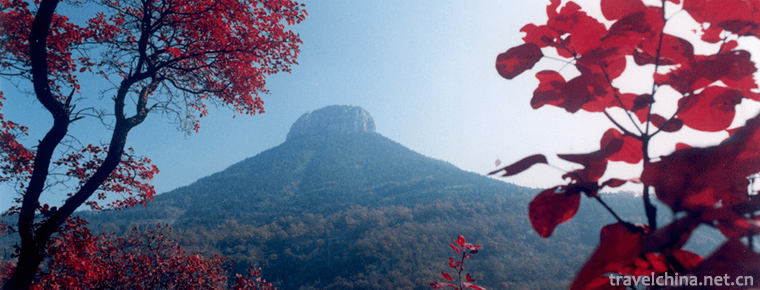
-
Mount Heng
Mt. Hengshan, also known as "Tai Mt. Hengshan", is known as "Xuanwu mountain" and "Yushan". Among them, inverted Ma Pass, Bauhinia Pass, Pingxiaoguan Pass, Yanmen Pass.
Views: 197 Time 2018-10-30 -
Qin Lake National Wetland Park
Qinhu National Wetland Park is located between the central part of Jiangsu Province and the Yangtze and Huaihe River. .
Views: 182 Time 2018-12-06 -
Jinan World First Spring Scenic Area
Jinan World No. 1 Spring Scenic Area, located in the center of Jinan City, Shandong Province, is a national AAAAA-level tourist attraction, national key park, advanced unit of national spiritual civil.
Views: 187 Time 2018-12-08 -
Chengdu JinJiang Hotel
Jinjiang Hotel is the first five-star hotel in southwest China. It is located in Renmin South Road, the main road of Chengdu City, adjacent to the famous Funan River and echoes Tianfu Square.
Views: 137 Time 2018-12-16 -
Chengdu Maoye JW Marriott Hotel
Chengdu Maoye JW Marriott Hotel is located in Tianfu Square, the heartland of Chengdu. It is about 30 minutes'drive from Chengdu Shuangliu International Airport to the hotel, opening the extraordinary.
Views: 226 Time 2018-12-16 -
The Grand View Garden Area of Shanghai
Shanghai Grand View Garden is located at 701 Qingshang Highway, Qingpu District, Shanghai. It is situated on the west side of Dianshan Lake, 65 kilometers away from downtown Shanghai..
Views: 150 Time 2018-12-19 -
Dongping Lake Scenic Spot
The total area of Dongping Lake Scenic Spot is 627 square kilometers, the annual water surface is 209 square kilometers, the average water depth is 2.5 meters, and the total water storage is 4 billion.
Views: 164 Time 2018-12-20 -
Bayi Memorial Hall in Nanchang
The Bayiyi Memorial Hall in Nanchang was established in 1956 and officially opened to the outside world on October 1, 1959. In 1961, it was announced by the State Council as the first batch of key nat.
Views: 155 Time 2018-12-31 -
Traditional Cotton Textile Techniques
Chinese traditional textile technology has a long history. Since cotton was introduced from India in the 7th century, Chinese textile industry has changed from linen to cotton. .
Views: 220 Time 2019-04-19 -
Uygur Medicine
Uygur Medicine magazine provides medical workers with good opportunities for education, continuing education and academic exchange platform, and is committed to improving the comprehensive quality of .
Views: 287 Time 2019-06-26 -
Han Xin
Han Xin (about 231 - the first 196). The Warring States period Han Xiang Wang Ji Kun Shu sun, in order to avoid the military strategist with the same name, Huaiyin Hou Hanxin Mixed up, historical book.
Views: 163 Time 2019-09-07 -
Beijing Language and Culture University
Beijing Language and Culture University, established in 1962 under the personal care of Premier Zhou Enlai, is a university directly under the Ministry of Education of China. In June 1964, it was name.
Views: 214 Time 2019-09-22
